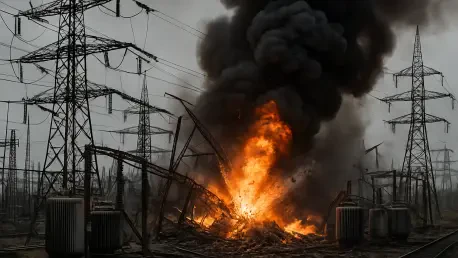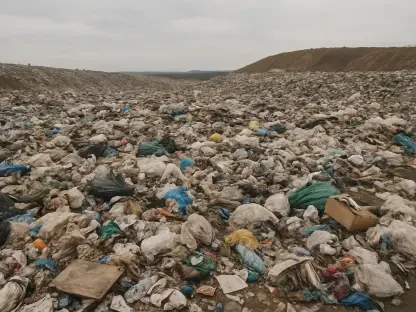In the heart of the ongoing conflict between Russia and Ukraine, a chilling and strategic battle has emerged, one that transcends traditional warfare and strikes at the very core of national survival—energy infrastructure. As winter’s bite looms on the horizon, both nations have intensified their efforts to dismantle each other’s power and fuel systems, turning substations, refineries, and gas facilities into critical targets. This is not merely a military tactic but a calculated move to cripple economies, disrupt daily life, and shatter societal resolve during the harshest months. The energy war reveals a grim dimension of modern conflict, where the ability to keep the lights on and homes warm becomes as pivotal as any battlefield victory. Delving into this escalating struggle, it’s evident that both sides are locked in a war of attrition, where every strike on a power grid or fuel depot is a blow to the opponent’s endurance. This article explores the intricate and devastating ways in which energy systems have become weapons, examining the tactics, impacts, and broader implications of this relentless campaign.
Russia’s Strategic Onslaught on Ukraine’s Power Systems
The Russian approach to weakening Ukraine centers on a systematic assault on its energy infrastructure, aiming to plunge the nation into darkness and despair. Since the conflict’s escalation in 2022, Ukraine’s energy capacity has been nearly halved, with power plants, transmission lines, and substations bearing the brunt of sustained attacks. Russian forces have honed their strategy to trigger blackouts and systemic failures, with historical strikes—such as the massive missile barrage in November 2022—causing emergency shutdowns of nuclear facilities and leaving millions without electricity for hours. More recently, the focus has expanded to include natural gas infrastructure, critical for heating during Ukraine’s brutal winters, with attacks slashing production capacity significantly. The intent is clear: to maximize hardship by disrupting not just power but also warmth, creating conditions that test the limits of human endurance as temperatures plummet.
Beyond the physical destruction, Russia’s tactics are designed to inflict deep psychological wounds on the Ukrainian populace. Employing a region-by-region strategy, attacks are concentrated on vulnerable eastern areas near conflict zones to fragment the national grid and overburden western regions. Nightly drone assaults, often involving hundreds of units, have evolved to be faster and more difficult to intercept, reflecting an adaptation to more lethal and precise weaponry. This shift underscores a deliberate effort to erode public morale by ensuring that the cold and dark become constant companions for Ukrainians. The overarching goal appears to be chaos, leveraging the harsh seasonal conditions to amplify the impact of each strike and push societal resilience to the breaking point.
Ukraine’s Determined Defense and Adaptation
Despite facing a barrage of attacks on its energy systems, Ukraine has displayed remarkable tenacity in preventing a total collapse of its grid. Protective measures, such as fortified structures around key substations, have been implemented alongside strategic localized outages to manage supply and demand. Significant investments, including $2.5 billion for gas imports and the development of alternative energy sources like secret battery storage parks and modular boiler systems, are bolstering capacity. Over a gigawatt of new power generation has been added, with further expansions underway, while air defense systems are prioritized to counter the relentless Russian drone and missile strikes. These efforts reflect a multifaceted approach to maintaining some semblance of normalcy amid chaos, ensuring that critical services remain operational even under duress.
Ukrainian society, too, has adapted to the grueling reality of energy scarcity with a resilience that defies the odds. Households and businesses rely heavily on generators, power banks, and portable batteries to navigate rolling blackouts that can last up to 14 hours daily. This grassroots response, coupled with government initiatives to secure alternative supplies, mitigates the immediate impact of disrupted power and heating. While the challenges remain daunting, especially with winter’s approach, the narrative of unpreparedness often pushed by adversarial propaganda is countered by tangible progress and societal grit. The focus remains on endurance, with every measure taken aimed at outlasting the sustained pressure from across the border.
Ukraine’s Bold Counterattacks on Russian Energy Assets
Turning the tables, Ukraine has launched an aggressive counteroffensive targeting Russia’s energy infrastructure, striking deep into enemy territory to mirror the pain inflicted on its own systems. Since August, over 60 attacks using domestically developed long-range drones and missiles have hit refineries, fuel depots, pumping stations, and export terminals as far as 1,200 miles away. These operations, often supported by intelligence from allies like the United States, aim to disrupt military logistics and create domestic fuel shortages within Russia. The effects are evident: gasoline prices have soared to record highs, long queues form at gas stations, and export bans have been imposed to manage dwindling supplies. Ukrainian officials estimate a 20% reduction in Russia’s refining capacity, a blow to both economy and morale.
These retaliatory strikes are not just about immediate disruption but also about imposing long-term economic costs on Russia. By targeting export terminals and critical fuel infrastructure, Ukraine seeks to undermine a key revenue stream for the Kremlin, while simultaneously bringing the war’s consequences to Russian civilians through rationing and shortages in regions like occupied Crimea. This strategy marks a significant shift, transforming Ukraine from a defensive player into an active aggressor on the energy front. The cumulative impact of these attacks is designed to pressure both the Russian government and its populace, highlighting that the conflict’s burden is not one-sided and challenging the notion of invulnerability far from the front lines.
Economic and Social Repercussions for Both Nations
The energy war exacts a heavy toll on the economic and social fabric of both Ukraine and Russia, with consequences that ripple through daily life. In Ukraine, the destruction of power and gas infrastructure poses a dire threat as winter nears, risking not only blackouts but also a severe heating crisis that could strain public patience to its limits. Yet, government efforts to secure alternative energy sources and societal adaptations like reliance on backup power systems provide a buffer against total breakdown. The economic burden of rebuilding and sustaining energy capacity amid conflict adds another layer of difficulty, diverting resources from other critical needs. Still, the Ukrainian resolve to endure these hardships remains a powerful counterweight to the challenges faced.
In contrast, Russia grapples with its own set of domestic fallout from Ukraine’s retaliatory strikes, which disrupt fuel availability and hit at the heart of its export-driven economy. Record-high fuel prices and rationing have led to visible frustration, with long lines at gas stations becoming a common sight and regional restrictions adding to public discontent. The economic strain from lost refining capacity and export revenue compounds military costs, creating a slow but persistent drag on national stability. While neither side has landed a decisive blow through these energy attacks, the gradual accumulation of social and economic pressure could influence the broader trajectory of the conflict, testing the limits of patience and resources on both fronts.
Escalating Tactics in a War of Attrition
The energy conflict between Russia and Ukraine is marked by a continuous evolution of tactics, reflecting a steep learning curve on both sides as they adapt to each other’s moves. Russia has refined its approach from broad, indiscriminate strikes to a more targeted, regional focus, aiming to split Ukraine’s grid and maximize disruption in specific areas. The use of advanced drones in nightly barrages, numbering in the hundreds, showcases an upgrade in precision and lethality, making interception increasingly difficult. This tactical shift is not just about physical damage but about compounding stress on Ukraine’s systems and populace, aligning with a broader strategy of sustained attrition over immediate victory.
Ukraine, meanwhile, has embraced technological innovation and international support to execute deep strikes into Russian territory, a stark departure from a purely defensive posture. The deployment of long-range drones and missiles to hit critical energy assets demonstrates a willingness to escalate the energy war and bring tangible costs to Russia’s doorstep. This mutual intensification underscores the nature of the conflict as one of endurance, where success is measured not by singular, dramatic wins but by the ability to inflict consistent, cumulative damage. As both nations refine their strategies, the energy front remains a brutal parallel to ground warfare, with each side determined to outlast the other through relentless pressure.
Winter’s Critical Challenge
As the winter of 2023-2024 draws near, the energy war emerges as a defining test of resilience for both Ukraine and Russia, with seasonal conditions amplifying the stakes. For Ukraine, surviving an expected surge in Russian attacks on power and heating infrastructure will be a monumental challenge, one that could push societal endurance to its limits if blackouts and cold become pervasive. The government’s preparatory measures, from energy storage to protective fortifications, will face their sternest trial, with the outcome potentially shaping public morale and the nation’s capacity to sustain resistance. The cold months are not just a backdrop but a weapon in this conflict, one that could tilt the balance if energy systems falter.
Russia, too, faces a winter crucible as it contends with the domestic fallout from Ukraine’s strikes on fuel infrastructure. Managing shortages, rationing, and export losses under the strain of public dissatisfaction will test economic stability and governmental control. The ability to repair damaged facilities and maintain supply amid ongoing attacks will be crucial, as failure could deepen internal discontent and weaken military logistics. This seasonal battle within the broader energy war may well reveal which nation is better equipped to withstand the grinding costs of attrition, with winter serving as a harsh arbiter of strategic success and national fortitude in this unrelenting struggle.
Broader Impacts and Elusive Peace
The energy conflict reverberates far beyond the borders of Russia and Ukraine, sending shockwaves through global energy markets and geopolitical alignments. Disruptions to Russian fuel exports, a consequence of Ukraine’s targeted strikes, influence international trade dynamics, affecting prices and supply chains for third-party nations. The involvement of external powers, such as the United States providing intelligence for Ukraine’s deep strikes, adds a layer of complexity to an already fraught situation, signaling shifting stances in global politics. Yet, the absence of effective mediation and the failure of past limited truces highlight the entrenched nature of this struggle, with little prospect for de-escalation on the horizon.
Looking back, the inability to broker a lasting ceasefire or energy-specific agreement during earlier phases of the conflict, such as the short-lived truce in 2023, underscored the deep mistrust between the two sides. Russia’s consistent rejection of peace proposals further dimmed hopes for a negotiated respite. As the energy war persisted, its global implications became increasingly evident, reshaping trade relationships and drawing international attention to the cascading effects of localized destruction. Moving forward, the focus must shift to exploring robust diplomatic channels and incentivizing temporary halts in energy-targeted attacks, while nations worldwide brace for potential ripple effects on energy security in the months ahead.









